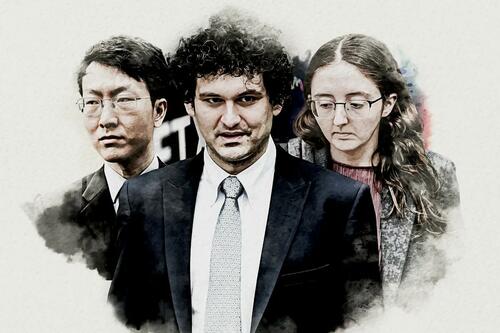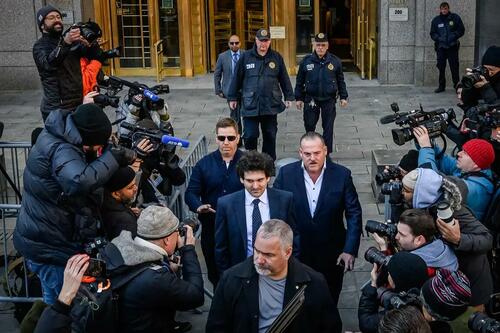Why Bankman-Fried’s FTX Fraud Trial Isn’t Going His Way
Authored by Kevin Stocklin via The Epoch Times (emphasis ours),

The trial of Sam Bankman-Fried has thus far strongly supported the prosecution’s charges of securities fraud, analysts say; meanwhile, any questions regarding his massive political donations have been put off for another day.
Since its start on Oct. 3, the trial has featured compelling testimony from former colleagues FTX co-founder Gary Wang and Alameda CEO Caroline Ellison, both of whom pointed the finger at Mr. Bankman-Fried—also known by his initials, SBF—as the ringmaster of one of the largest financial frauds in U.S. history. The defense has struggled to make its case, although Mr. Bankman-Fried’s attorneys may still have cards to play.
“As of now, it’s not going well for the defense,” Braden Perry, a former federal enforcement attorney who’s currently a partner at Kennyhertz Perry, told The Epoch Times. “Both Ellison and Wang have testified that SBF directed them to commit the crimes.”
The prosecution has been methodically building its case, Mr. Perry said. Assistant U.S. Attorneys Nicolas Roos and Danielle Sassoon presented consistent testimony that Mr. Bankman-Fried knowingly and intentionally defrauded investors, and they also made efforts to humanize the losses suffered by FTX customers.
“The evidence that has come out over the first two weeks of trial is all to the point that SBF was involved, either directly or indirectly, in a conspiracy with people who themselves have pled guilty to committing fraud,” Daniel Silva, a former federal prosecutor who’s currently a shareholder at business law firm Buchalter, told The Epoch Times.
The prosecution’s case thus far “is very strong,” he said.
And while cryptocurrencies are arcane financial instruments, the case itself is straightforward.

A Simple Tale of Theft and Deceit
“It’s a typical corporate fraud case,” Mr. Silva said. “The product may have been complex, but the fraud itself is not unique. Basically, the allegations are that [the defendants] improperly and deceptively took money from customers and investors for FTX owners’ personal use.”
The prosecution has largely avoided delving into the intricacies of cryptocurrencies, focusing instead on the simpler narrative of theft and deceit.
“What this trial boils down to is FTX’s use and Alameda’s use of customer funds,” Mr. Perry said. “The prosecution will need to prove SBF used those funds knowingly and fraudulently.”
According to the allegations, “SBF was the front of the entire enterprise, including Alameda,” he said. “Further, SBF used a massive [line of credit,] which was not disclosed to Alameda customers or investors.”
While approximately $9 billion of customers’ and investors’ money has gone missing in the 2022 collapse of crypto exchange FTX and its affiliated hedge fund Alameda Research, the trial on Oct. 4 featured testimony from an individual investor who had lost $100,000 on the FTX crypto exchange to show jurors how retail investors were personally harmed.
This was an “interesting start.” according to Mr. Perry.
“It shows how a typical investor was duped by the ‘safeness’ of FTX,” he said.
The prosecution then laid the foundation of its case with testimony from Mr. Wang, FTX’s former chief technology officer, who said he coded the accounts of Alameda Research to allow it to run negative balances on the FTX exchange. This gave Alameda the ability to borrow money from the exchange and ultimately to take clients’ funds—without their knowledge or consent—to pay off billions of dollars in loans and trading losses and to lend money to FTX executives for their personal use.
Mr. Wang said Alameda accounts were set up this way at the direction of Mr. Bankman-Fried but that this special arrangement between the two companies was kept secret from FTX customers. Mr. Wang pled guilty to charges of securities fraud and accepted a plea deal with prosecutors to testify against Mr. Bankman-Fried.
The prosecution’s case then shifted to how customers’ money was taken by Alameda Research.
Ms. Ellison took the stand next and accused Mr. Bankman-Fried of directing her to use Alameda’s credit line with FTX to repay approximately $10 billion in loans, which she could only do by taking money from FTX customers. She said he also instructed her to deceive Alameda creditors regarding the extent of its indebtedness.
Her testimony became emotional when during cross-examination, she broke down in tears and said she lived in “dread” that her actions to deceive investors would come to light and that when Alameda and FTX finally collapsed, it brought her an “overwhelming feeling of relief.”
Defense Fights Uphill Battle
In sum, this evidence has put the defense in a particularly challenging position, analysts say.
You can attack testimony and witnesses and their credibility and recollection, which it sounds like they’re trying to do,” Mr. Silva said. “But at the end of the day, when you have multiple people saying the same thing—basically that SBF committed fraud and directed us to commit fraud—it’s really tough to undermine those witnesses or the impact of that.
“Strategically, there’s only so much you can do.
“Even if you’re the greatest [attorney] in the world, you can’t make evidence disappear.”
The defense, indeed, appears to be floundering.
Lead defense attorney Mark Cohen had argued in his opening statement that Mr. Bankman-Fried’s associates were the actual perpetrators and that his client was either unaware of or not directly involved in their crimes. Mr. Bankman-Fried stepped down as CEO of Alameda Research in October 2021, handing the reins to Ms. Ellison.
Mr. Cohen succeeded in getting Ms. Ellison to admit to instances in which Mr. Bankman-Fried wasn’t directly involved in the workings of Alameda, but he largely failed to discredit her overall testimony that Mr. Bankman-Fried was the ultimate decision-maker, legal analysts say.
Mr. Cohen’s line of questioning appeared to ramble at times, repeatedly changing topics and dates and, at one point, referencing a wrong document. Another time, he paused to say he’d lost his place.
Read more here…
Tyler Durden
Thu, 10/19/2023 – 16:20 Source
 RSS Feed
RSS Feed















 October 20th, 2023
October 20th, 2023  Awake Goy
Awake Goy  Posted in
Posted in  Tags:
Tags: 













